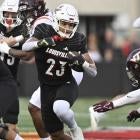We've spent considerable time this offseason discussing the Steelers' high-powered offense. But if this team is to get past the Patriots, something it has yet to do in the postseason during the Ben Roethlisberger era, it will be because the unit no one is talking about -- the defense -- exceeds expectations.
It wasn't that long ago that the Steelers' defense was the league's most formidable unit. In 2010, the year Pittsburgh lost to Green Bay in the Super Bowl, its defense finished the regular season ranked No. 1, according to Football Outsiders' metrics. Defensive coordinator Dick LeBeau, 73 years old at the time, was still considered in his prime, and names like Casey Hampton, Brett Keisel, James Farrior, LaMarr Woodley, Lawrence Timmons, Ike Taylor, Troy Polamalu, Ryan Clark and James Harrison wreaked havoc on unsuspecting offenses. Almost seven years later, only the 39-year-old Harrison remains.
In fact, the Steelers' defense got progressively worse -- and older -- after the 2010 campaign, dropping to seventh per Football Outsiders in 2011, 13th in 2012, 19th in 2014 and finally bottoming out at No. 30 in 2014. LeBeau was replaced by linebackers coach Keith Butler ahead of the 2015 season and the group improved to 11th, which is where they finished in 2016 too.
But those improvements weren't solely because of a coaching change; the defense got considerably younger and faster, starting the year before LeBeau left. The Steelers drafted rush linebacker Jarvis Jones in 2013, and while he never came close to replicating the success he had in college, the organization's game plan was clear: shore up a unit that was one of the league's oldest. In 2014, Pittsburgh drafted inside linebacker Ryan Shazier and defensive end Stephon Tuitt with its first two picks, and a year later, doubled down with rush linebacker Bud Dupree and cornerback Senquez Golson. The run on defenders continued in 2016; cornerback Artie Burns, safety Sean Davis and defensive tackle Javon Hargrave were taken in each of the first three rounds, and this spring the Steelers selected rush linebacker T.J. Watt 30th overall to replace Jones, who wasn't re-signed in the offseason.
(The Steelers are back at training camp! Don't MISS anything as they prepare to try and return to the playoffs -- take five seconds to Sign up for our Free Steelers newsletter now!)
Youth and inexperience come with growing pains, but coaches can work with that, especially given the alternative, which is encapsulated nicely in colleague Pete Prisco's favorite saying: "Old and slow and you must go." For the Steelers this means that only two starters remain from the 2014 squad that was one of the league's worst -- defensive end Cam Heyward and safety Mike Mitchell, who are also two of Pittsburgh's most reliable players. And at 28 and 30, Heyward and Mitchell will be Pittsburgh's two oldest starters on defense (assuming ageless wonder James Harrison splits time at outside linebacker).
Taking the next step
So what's the next step for this group that has finished ranked 11th in defense in 2015 and 2016? "Strong up the middle" sounds like a cliche, but there's a lot of truth in those four words too. Hargrave, Shazier, and Davis are young and formidable, and along with Mitchell make up the backbone of this unit. Heyward, who missed nine games with an injured pectoral muscle last year, is one of the team's most tenacious pass rushers, and he and Tuitt are arguably the league's most underrated pair of defensive ends. Dupree at outside linebacker might be the unit's best athlete, and he'll be paired with Watt, another physical freak who was a tight end before switching to defense. (Fun fact: Both Watt and Dupree are 6-foot-4, and both ran sub-4.7 40s at the combine.) Then there's Burns, who is coming off a solid rookie season but will need to play better in Year 2. The Steelers keep trying to replace the other corner, Ross Cockrell, but he refuses to be replaced.
Other than what Watt will contribute and how soon, perhaps the biggest question facing this group is the sub-package defenders. Specifically, can Golson, who has yet to make it through an NFL training camp (never mind an actual game), earn a roster spot and contribute? The team was high on him when he was drafted two years ago, but after a foot injury sidelined Golson for all of 2016, general manager Kevin Colbert doesn't sound quite as optimistic as he once did.
"Last year I sat here and said we would view him as an extra draft pick and unfortunately we can't do that right now," Colbert said of Golson back in April, shortly before the Steelers drafted cornerback Cam Sutton in the third round. "Again, through no fault of his own, he has been injured two years in a row and in all honesty, I worry about a defensive back coming off of a foot injury because you don't know what he's going to be like and we won't know until we get into the OTAs and mini-camps, and things of that nature. "So, I hope he does for his sake, for our sake, but it's less predictable at this point because we're dealing with two injuries. And two years off, I don't think you can minimize not playing for two seasons. You have to get back. He has to re-learn a lot of football and his body has to re-learn a lot of football movement."
Golson will face competition from the aforementioned Sutton and veteran Will Gay, who ranked 14th among all cornerbacks last season, according to Pro Football Focus' grades, but was repeatedly exposed by Tom Brady and the Patriots in January's AFC Championship Game. Which brings us to one of the Steelers' offseason priorities: improving their man-to-man defense.
A dynasty-sized obstacle
It's no secret that Pittsburgh's biggest obstacle to getting back to the Super Bowl remains the New England Patriots. We were all reminded of this when the Pats easily dispatched the Steelers in last season's AFC title game, 36-15.
In fact, in the Tom Brady-Bill Belichick era, the Pats are 8-2 against the Steelers, with one of the losses coming with Matt Cassel under center. The two teams will meet in Heinz Field this season on Dec. 17, perhaps offering a glimpse of not only the playoffs, but the Steelers' latest plan to slow Brady.
The Steelers faced the Patriots in Heinz Field last October, but that was without Roethlisberger. Backup Landry Jones was serviceable, but the Pats prevailed 27-16. The last time the Patriots came to Pittsburgh with Big Ben under center -- October 2011 -- was also the last time the Steelers beat them. In that game, one that has been referenced several times in the wake of January's beatdown, the Steelers abandoned the zone defense they were known for and relied heavily on a man-to-man scheme that disrupted Brady's ability to get the ball out quickly. That, along with getting after Brady -- he was pressured for much of the game and was sacked three times -- was critical to Pittsburgh's success.
It was something of a surprise when the Steelers played mostly zone in last January's matchup, which afforded them a front-row seat to a Brady-led whipping, but not much else. Then again, apparently it didn't matter what the scheme was because as the Pittsburgh Post-Gazette's Gerry Dulac noted at the time, Pittsburgh played man-to-man on at least three occasions in that game and on three occasions Brady burned them.
Oh, and there's this:
Biggest culprit in man coverage was nickel back William Gay, who struggled w Edelman.
— Gerry Dulac (@gerrydulac) January 24, 2017
In March, coach Mike Tomlin basically confirmed what everybody already knew.
"Our inability to play man-to-man effectively and our inability to apply pressure on the quarterback without blitzing were issues in that game," Tomlin said of the playoff loss to the Patriots.
Put another way: Zone schemes might work against replacement-level quarterbacks, and even quarterbacks who are above average. But when you're facing Brady, there is no margin for error because he and Belichick will exploit every weakness -- repeatedly.
But as Tomlin alluded to, this isn't just about the secondary. The front seven have to get after the passer. Heyward made this point in the aftermath of the latest loss to the Patriots.
"I think we have to get more pressure,'' he said at the time, via the Post-Gazette. "I know we got a sack with Hargrave, but [Brady] can't be sitting back there all day dissecting our defense because there's always going to be a spot open on defense, it's how well you cover it up. The great equalizer is the great pass rush, and we have to get more pressure."
This reminds us of something former linebacker Larry Foote said during the Steelers' 2013 training camp. Harrison had signed with the Bengals in the offseason and Pittsburgh was looking to rookie Jarvis Jones or veteran Jason Worilds to replace him. Ultimately, playing time would come down to one thing: sacks.
"It's wide open," Foote told CBSSports.com at the time. "In preseason and early in the season, if you're sacking the quarterback, you gotta play. Coach can't keep you off the field if you're sacking. So if Worilds wants to keep Jarvis behind him, you got to sack the quarterback."
Executing the game plan
The names have changed, but the game plan is the same. And it will require all 11 defenders -- pass rushers to disrupt the quarterbacks timing and the secondary to make those throwing windows as small as possible.
On paper, this all makes perfect sense and seems eminently doable. We'll know in the coming weeks and months if the 2017 Steelers defense can implement a strategy that has had limited success against their biggest obstacle to another Super Bowl appearance: Tom Brady and the Patriots.






















